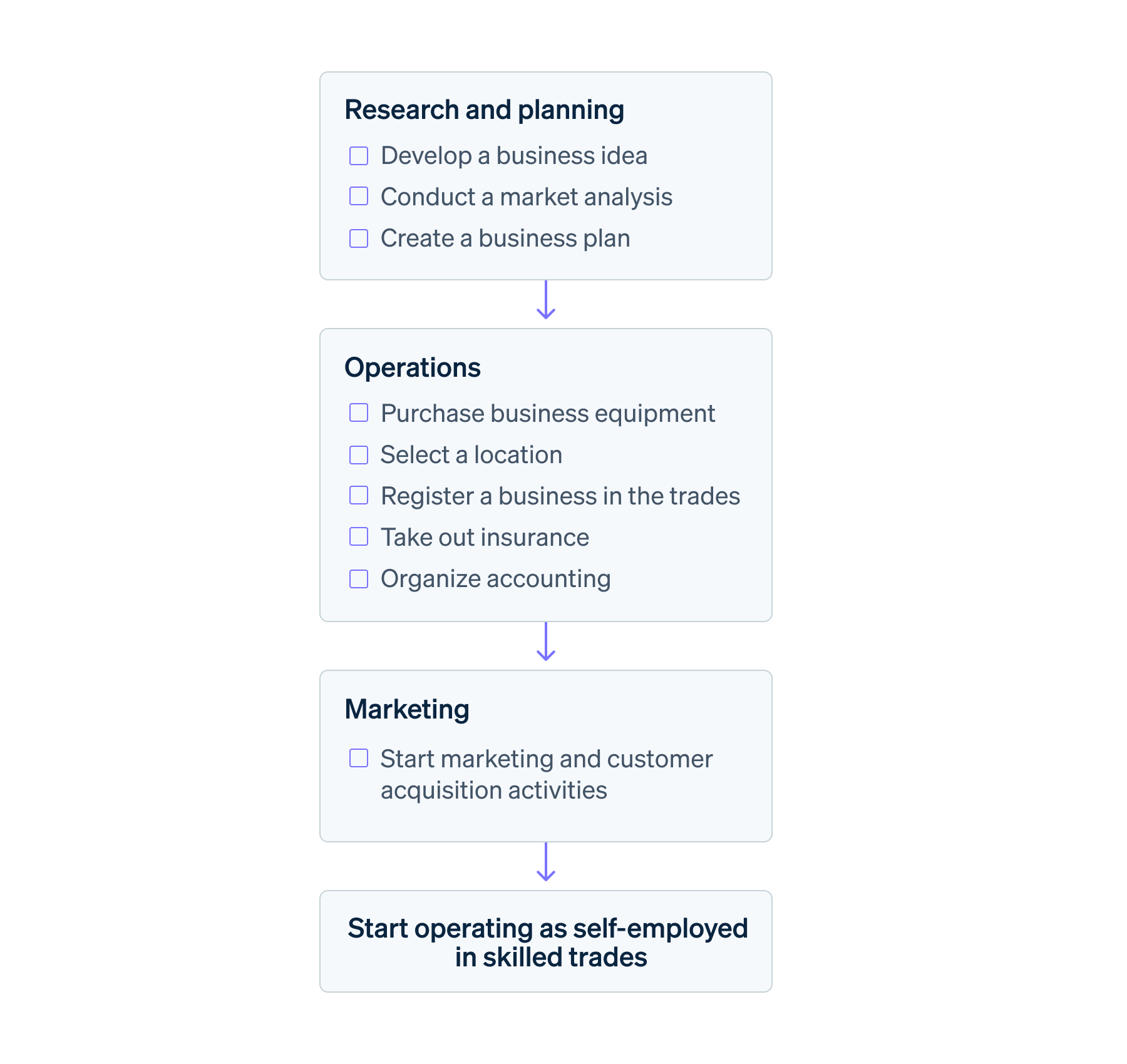ตามข้อมูลของสมาพันธ์ช่างฝีมือเยอรมัน ปัจจุบันมีธุรกิจมากกว่า 1 ล้านแห่งในภาคส่วนนี้ในประเทศเยอรมนี โดยมีพนักงานประมาณ 5.6 ล้านคน หากคุณไม่อยากเป็นผู้ค้าขายแต่ต้องการเริ่มต้นธุรกิจของตนเอง คุณสามารถก้าวเข้าสู่การประกอบอาชีพอิสระได้ บทความนี้จะอธิบายข้อกำหนดส่วนบุคคล ข้อกำหนดทางอาชีพ และข้อกำหนดทางกฎหมายสำหรับการทำงานอิสระ ตลอดจนเวลาที่จำเป็นต้องมีใบรับรองช่างฝีมือระดับสูง นอกจากนี้เรายังอธิบายวิธีสร้างธุรกิจของคุณเองแบบทีละขั้นตอน ค่าใช้จ่ายที่คุณต้องจ่าย และสิ่งที่คุณจะได้รับในฐานะบุคคลทั่วไปที่ประกอบอาชีพอิสระ
บทความนี้ให้ข้อมูลอะไรบ้าง
- ข้อกําหนดสําหรับการเป็นผู้ค้าขายอิสระมีอะไรบ้าง
- เมื่อใดต้องมีใบรับรองช่างฝีมือระดับสูง
- คุณจะเริ่มทําธุรกิจในด้านการค้าที่มีทักษะได้อย่างไร
- การเป็นผู้ค้าขายอิสระมีค่าใช้จ่ายเท่าใด
ข้อกําหนดสําหรับการเป็นผู้ค้าขายอิสระมีอะไรบ้าง
มีข้อกำหนดทางวิชาชีพและกฎหมายมากมายสำหรับการเป็นผู้ประกอบอาชีพอิสระ ในผู้ค้าขาย:
ข้อกําหนดด้านวิชาชีพ
ประสบการณ์การทำงานเป็นรากฐานของความสามารถทางวิชาชีพและความไว้วางใจของลูกค้า ซึ่งสามารถพิสูจน์ได้ว่าคุณได้นำทักษะของตนเองไปใช้ในสถานการณ์จริงมาแล้ว ประสบการณ์การทำงานหลายปีจะไม่เพียงแต่ช่วยให้คุณพัฒนาฝีมือของตนเองให้สมบูรณ์แบบเท่านั้น แต่ยังช่วยพัฒนาความเข้าใจที่ลึกซึ้งถึงกระบวนการและความท้าทายของอาชีพนี้อีกด้วย นอกจากนี้ยังช่วยคุณแก้ปัญหาได้อย่างมีประสิทธิภาพ คำนวณต้นทุนอย่างถูกต้อง และดําเนินธุรกิจให้ประสบความสําเร็จ
นอกจากนี้ ความรู้เชิงพาณิชย์ยังจำเป็นต่อการทำงานอิสระด้วย ผู้ค้าขายที่ประกอบกิจการด้วยตัวเองต้องคํานวณค่าใช้จ่าย จัดเตรียมใบเสนอราคา และสร้างใบแจ้งหนี้ จัดการงบประมาณ ชําระเงินภาษี และจัดระเบียบการทําบัญชี ทักษะเหล่านี้ช่วยให้มีราคาสามารถแข่งขันได้ ติดตามรายรับและรายจ่าย และรักษากำไรในระยะยาว ด้วยความรู้นี้ ผู้ประกอบการที่มีประสบการณ์สามารถรักษาการดําเนินงานให้เป็นไปตามแผน
ข้อกําหนดทางกฎหมาย
การฝึกอบรมด้านอาชีพที่มั่นคงเป็นรากฐานสำหรับการประกอบอาชีพอิสระที่ประสบความสำเร็จในสาขาอาชีพที่ต้องใช้ทักษะ และเป็นสิ่งสำคัญสำหรับการเรียนรู้ความเชี่ยวชาญเฉพาะทางทั้งทางทฤษฎีและทางปฏิบัติ อย่างไรก็ตาม ในบางกรณี เพียงเท่านี้ยังไม่เพียงพอที่จะประกอบอาชีพอิสระ ยังต้องใช้ใบรับรองช่างฝีมือระดับสูงด้วย
ผู้ประกอบอาชีพอิสระยังต้องปฏิบัติตามข้อกำหนดทางกฎหมายบางประการเพื่อดำเนินธุรกิจตามกฎหมายด้วย ซึ่งรวมถึงการจดทะเบียนอย่างเหมาะสมกับหน่วยงานต่างๆ เช่น สํานักงานการค้าและภาษี สมาคมวิชาชีพที่เกี่ยวข้อง ตลอดจนการปฏิบัติตามสัญญาและกฎหมายการจ้างงาน โดยเฉพาะอย่างยิ่ง จะต้องปฏิบัติตามระเบียบข้อบังคับด้านอาชีวอนามัยและความปลอดภัยเพื่อความปลอดภัยของพนักงาน นอกจากนี้ ผู้ค้าขายยังต้องปฏิบัติตามหลักการบัญชีที่ถูกต้อง (อ้างอิงจาก GoBD หรือ “หลักการจัดการและจัดทำบัญชี บันทึก และเอกสารในรูปแบบอิเล็กทรอนิกส์อย่างเหมาะสม”
อีกทั้งยังต้องพิจารณานโยบายที่เหมาะสมเพื่อให้เป็นไปตามข้อกำหนดทางกฎหมายและรักษาความมั่นคงทางการเงินของธุรกิจ ตัวอย่างเช่น ประกันภัยความรับผิดทางธุรกิจคือกุญแจสําคัญในการปกป้องจากการเรียกร้องค่าเสียหาย ความคุ้มครองทางกฎหมายและความพิการยังถือเป็นทางเลือกที่สำคัญอีกด้วย
เมื่อใดต้องมีใบรับรองช่างฝีมือระดับสูง
ในเยอรมนี อาชีพมากกว่า 130 อาชีพได้รับการจัดประเภทเป็นอาชีพที่ต้องใช้ทักษะ ซึ่งสามารถแบ่งออกได้เป็น 7 สาขา ดังนี้
- การก่อสร้างและการขยาย
- งานฝีมือเสื้อผ้า สิ่งทอ และเครื่องหนัง
- การค้าด้านสุขภาพและการดูแลส่วนบุคคล การค้าทางเคมีและการทําความสะอาด
- การออกแบบกราฟิก
- ไม้และพลาสติก
- งานฝีมือด้านอาหาร
- โลหะและไฟฟ้า
ประมวลกฎหมายการค้าและหัตถกรรม ของเยอรมัน (HwO) แบ่งอาชีพต่างๆ ออกเป็นอาชีพที่ต้องมีใบอนุญาตและอาชีพที่ไม่ต้องใช้ใบอนุญาต แบบแรกต้องมีใบรับรองจาก Chamber of Crafts (HWK) จึงจะเริ่มต้นธุรกิจในสาขานี้ได้ วิธีนี้จะเป็นการต่อยอดการฝึกอบรมด้านอาชีพ และเป็นคุณสมบัติเพิ่มเติมในด้านหัตถกรรม ศิลปะ เทคนิค-พาณิชย์ และเกษตรกรรม
สมมติว่าคุณไม่มีตำแหน่งระดับขั้นสูง แต่ต้องการจัดตั้งธุรกิจของคุณเองในสาขาอาชีพที่ต้องมีใบอนุญาต ในกรณีนี้คุณสามารถจ้างผู้ค้าขายระดับสูงแบบเต็มเวลาในตําแหน่งผู้จัดการ หรือใช้ข้อบังคับของช่างที่ได้รับการฝึกฝนมาอย่างดี กรณีนี้ต้องมีหลักฐานว่าผู้ก่อตั้งมีประสบการณ์อย่างน้อย 6 ปีในฐานะช่างที่ได้รับการฝึกฝนมาอย่างดี รวมถึงอย่างน้อย 4 ปีในตำแหน่งผู้บริหาร
งานฝีมือที่จำเป็นต้องมีใบอนุญาตนั้นต้องผ่านการสอบช่างฝีมือระดับสูงเนื่องจากจะต้องเป็นไปตามมาตรฐานคุณภาพพิเศษและข้อกำหนดด้านความปลอดภัย ซึ่งบังคับใช้กับช่างไฟฟ้า หลังคา และช่างประปา ภาคผนวก A ของประมวลกฎหมายแรงงาน (HwO) ระบุอาชีพที่ต้องมีใบอนุญาต ภาคผนวก B ครอบคลุมถึงอาชีพทุกประเภทที่ไม่จำเป็นต้องมีใบอนุญาต รวมถึงช่างทำนาฬิกา ช่างทำรองเท้า และช่างภาพ
คุณจะเริ่มทําธุรกิจในด้านการค้าที่มีทักษะได้อย่างไร
ทุกคนที่ต้องการเริ่มต้นธุรกิจของตนเองจะต้องดำเนินการอย่างเป็นระบบเพื่อให้เป็นไปตามข้อกำหนดทางกฎหมายและองค์กรทั้งหมด ต่อไปนี้เป็นขั้นตอนสําคัญที่สุดในการเริ่มทําธุรกิจประเภทนี้:

ขั้นตอนที่ 1: พัฒนาแนวคิดทางธุรกิจ
ก่อนอื่นคุณต้องกําหนดอย่างชัดเจนว่าผลิตภัณฑ์และบริการใดที่คุณต้องการนําเสนอและให้ใคร พื้นฐานสําหรับขั้นตอนนี้คือความเชี่ยวชาญเฉพาะทางที่คุณได้เรียนรู้และฝึกฝนอยู่ ในขณะเดียวกัน คุณต้องตรวจสอบว่าการค้าของคุณต้องมีใบอนุญาตหรือไม่ สิ่งสำคัญคือคุณต้องมีคุณสมบัติทางวิชาชีพที่จำเป็นในการประกอบอาชีพอิสระในสาขาอาชีพเฉพาะของคุณ เป้าหมายของแนวคิดทางธุรกิจที่ดีจะต้องมีตำแหน่งที่ชัดเจน โดยควรมีจุดขายที่เป็นเอกลักษณ์
ขั้นตอนที่ 2: ดำเนินการวิเคราะห์ตลาด
ขั้นตอนที่สองคือการวิเคราะห์ตลาดที่มีอยู่ มีความต้องการผลิตภัณฑ์หรือบริการของคุณหรือไม่ องค์กรของคุณมีขนาดและศักยภาพในระดับใด คุณจะทําธุรกิจในพื้นที่ใด ลูกค้าของคุณเป็นใคร และใครคือคู่แข่งของคุณ นอกจากนี้คุณจำเป็นต้องทราบว่าคู่แข่งของคุณเสนออะไร รวมถึงทราบราคาและส่วนแบ่งการตลาดของพวกเขา เช่นเดียวกัน คุณควรทราบถึงอุปสรรคที่อาจเกิดขึ้นในการเข้าสู่ตลาดและแนวโน้มทั่วไปและระดับภูมิภาคที่มีผลต่อธุรกิจของคุณด้วย ยิ่งคุณประเมินรายละเอียดมากเท่าไร คุณก็จะเตรียมความพร้อมสำหรับธุรกิจของคุณเองได้ดีขึ้นเท่านั้น
ขั้นตอนที่ 3: เลือกตําแหน่งที่ตั้ง
การเลือกตำแหน่งที่ตั้งที่เหมาะสมกับธุรกิจของคุณนั้นเกี่ยวข้องกับการวิเคราะห์ตลาดอย่างใกล้ชิด พื้นที่จะต้องเข้าถึงได้ง่ายสําหรับซัพพลายเออร์และผู้ที่มีโอกาสเป็นพนักงาน และใกล้กับลูกค้าของคุณ ตัวอย่างเช่น ร้านเบเกอรี่ที่มีหน้าร้านจะได้ประโยชน์จากสภาพแวดล้อมที่พลุกพล่าน ในทางกลับกัน บริษัทหลังคาอาจไม่ต้องพื้นที่ที่อยู่ใจกลางเมืองเนื่องจากงานต้องทำงานในสถานที่ของลูกค้า สิ่งสำคัญคือพื้นที่ดังกล่าวต้องเป็นไปตามข้อกำหนดทางกฎหมายและเหมาะสมต่อการปฏิบัติงาน
ขั้นตอนที่ 4: สร้างแผนธุรกิจ
ขั้นตอนที่หนึ่งถึงสามจะเป็นการเตรียมการสำหรับอีกขั้นตอนสำคัญหนึ่งในการเริ่มต้นธุรกิจ นั่นก็คือการสร้างแผนธุรกิจ ขั้นตอนจะผสานรวมผลการค้นคว้าข้อมูลและการตัดสินใจของคุณ นอกจากนี้ยังต้องครอบคลุมถึงแนวคิด การวิเคราะห์ตลาด กลุ่มเป้าหมาย การตลาดที่วางแผนไว้ การจัดหาเงินทุน และต้นทุน
ซึ่งเป็นสิ่งสําคัญสําหรับการจัดโครงสร้างโครงการของคุณ การวางแผนการจัดหาเงินทุน และโน้มน้าวใจนักลงทุนที่มีศักยภาพให้เชื่อในแนวคิดทางธุรกิจของคุณ
ขั้นตอนที่ 5: ซื้ออุปกรณ์สําหรับธุรกิจ
ขั้นตอนสําคัญอีกขั้นตอนหนึ่งในการเริ่มทําธุรกิจคือการซื้ออุปกรณ์ที่จําเป็น ต้องใช้เครื่องมือ เครื่องจักร และวัสดุเฉพาะเจาะจงขึ้นอยู่กับการค้าขาย และอาจต้องใช้ยานพาหนะในการขนส่งพนักงานและสินค้าด้วย โปรดปฏิบัติตามมาตรฐานความปลอดภัยและข้อกำหนดทางกฎหมายทั้งหมด เช่น การจัดเก็บวัสดุอันตรายหรือการตั้งเครื่องจักร
นอกจากนี้ อุปกรณ์นี้ยังมีฮาร์ดแวร์และซอฟต์แวร์สําหรับการจัดการกระบวนการด้านการบริหารด้วย ซึ่งรวมถึงโปรแกรมการทําบัญชี ซอฟต์แวร์การบันทึกเวลาและการเรียกเก็บเงิน และเครื่องมือดิจิทัลสําหรับการจัดการลูกค้าและการประมวลผลคําสั่งซื้อ หากคุณต้องการรับชําระเงินจากลูกค้าโดยตรงบนเว็บไซต์ โปรดดูข้อมูลเพิ่มเติมเกี่ยวกับ Stripe Terminal เมื่อใช้ Terminal คุณจะสามารถเปิดใช้การชําระเงินในสถานที่ได้ เช่น ด้วยเครื่องอ่านบัตรที่ผ่านการรับรองล่วงหน้า เช่น Stripe Reader S700 หรืออุปกรณ์เคลื่อนที่ เช่น BBPOS WisePad 3 ใช้ Tap to Pay ชําระแบบไร้เงินสดได้โดยไม่มีอุปกรณ์เพิ่มเติม
ขั้นตอนที่ 6: จดทะเบียนธุรกิจในการค้า
ข้อกําหนดอย่างเป็นทางการจะแตกต่างกันไปขึ้นอยู่กับการจัดตั้งธุรกิจตามกฎหมายของคุณ ผู้ค้าขายที่ประกอบอาชีพอิสระส่วนใหญ่ต้องลงทะเบียนกับ HWK การค้า และสำนักงานภาษี ในหลายๆ กรณี การจดทะเบียนพาณิชย์และการเป็นสมาชิกกับสมาคมวิชาชีพที่เกี่ยวข้องก็มีความจำเป็นเช่นกัน ทุกคนที่จ้างพนักงานต้องแจ้งต่อหน่วยงานประกันสังคม
ขั้นตอนที่ 7: ทำประกันภัย
ก่อนที่จะเริ่มดำเนินการ คุณต้องซื้อประกันภัยที่จำเป็นทั้งหมด โดยเฉพาะความคุ้มครองความรับผิดทางธุรกิจ
ขั้นตอนที่ 8: จัดระเบียบการทําบัญชี
กฎหมายกำหนดให้ต้องมีการทำบัญชีอย่างถูกต้อง และช่วยให้คุณติดตามรายได้ ค่าใช้จ่าย และภาษีของคุณได้ ในแต่ละกรณี การปรึกษาหารือกับที่ปรึกษาด้านภาษีอาจเป็นประโยชน์ นอกจากนี้คุณยังสามารถลดความซับซ้อนของกระบวนการบางอย่างได้ด้วยการใช้เครื่องมืออย่าง Stripe Invoicing เพื่อสร้างและส่งใบแจ้งหนี้ได้โดยอัตโนมัติ คุณจึงประหยัดเวลาในงานด้านการดูแลระบบได้อย่างมาก และช่วยป้องกันข้อผิดพลาดในการเรียกเก็บเงินได้ คุณจําเป็นต้องสร้างบัญชีธุรกิจเพื่อแยกกระแสเงินสดส่วนตัวและธุรกิจออกจากกัน
ขั้นตอนที่ 9: เริ่มทําการตลาดและกิจกรรมการหาลูกค้าใหม่
แนวคิดการตลาดของคุณเป็นส่วนหนึ่งของแผนธุรกิจของคุณอยู่แล้ว ซึ่งรวมถึงเว็บไซต์ด้านอาชีพ แผ่นพับ การส่งไปยังไดเร็กทอรีอุตสาหกรรมที่เกี่ยวข้อง และอาจรวมถึงการมีตัวตนบนแพลตฟอร์มโซเชียลมีเดียที่เลือกด้วย กุญแจสำคัญในการดึงดูดลูกค้าคือการเริ่มต้นทำการตลาดและหาลูกค้าตั้งแต่เนิ่นๆ
ขั้นตอนที่ 10: เริ่มต้นการดําเนินงาน
บริษัทของคุณสามารถรับคําสั่งซื้อรายการแรกได้ทันทีที่งานด้านกฎหมายและองค์กรทั้งหมดเสร็จสมบูรณ์แล้ว
การเริ่มต้นธุรกิจในการค้าได้ใน 10 ขั้นตอน:
การเป็นผู้ค้าขายอิสระมีค่าใช้จ่ายเท่าใด
ค่าใช้จ่ายรวมของการเริ่มต้นธุรกิจจะแตกต่างกันอย่างมาก ขึ้นอยู่กับประเภทขององค์กรขนาดและความต้องการของแต่ละบุคคล อย่างไรก็ตามคุณสามารถประมาณได้ว่าจะจ่ายอย่างน้อยหลายร้อยยูโร ทั้งนี้ไม่มีขีดจำกัดสูงสุด ต่อไปนี้เป็นค่าใช้จ่ายที่สำคัญที่สุดบางส่วน
- การฝึกอบรม รวมถึงการขอรับใบรับรองช่างฝีมือระดับสูง
- จดทะเบียนกับหน่วยงานราชการ เช่น สํานักงานการค้า
- อุปกรณ์การปฏิบัติงาน เช่น เครื่องมือและเครื่องจักร ยานพาหนะ และไอที
- ค่าเช่าและค่าใช้จ่ายเพิ่มเติมในสถานที่ทำธุรกิจ
- ประกันภัย
- คําแนะนําเกี่ยวกับภาษี
- การตลาดและการโฆษณา
- ค่าใช้จ่ายในการดําเนินงานต่อเนื่องสําหรับบุคลากร วัสดุ และอุปกรณ์
ผู้ค้าอิสระมีรายได้เท่าไร
รายได้ของผู้ประกอบอาชีพอิสระจะแตกต่างกันขึ้นอยู่กับต้นทุนที่อาจเกิดขึ้น ขึ้นอยู่กับประเภทของการค้า ภูมิภาค สถานการณ์การสั่งซื้อ ค่าใช้จ่ายในการดำเนินงาน และจำนวนพนักงานเป็นหลัก โดยเฉลี่ยแล้ว ชั่วโมงการทำงานในธุรกิจการค้าที่มีทักษะจะได้รับค่าตอบแทน 50 ถึง 80 ยูโรสุทธิ หากคุณคูณจำนวนนี้ด้วยจำนวนชั่วโมงทำงานที่คาดว่าจะทำ คุณจะสามารถกำหนดค่ารายได้ต่อเดือนโดยประมาณได้ อย่างไรก็ตาม ควรจำไว้ว่าคุณต้องวางแผนเวลาทำงานสำหรับงานธุรการด้วย สุดท้าย คุณต้องหักค่าใช้จ่ายต่างๆ
เนื้อหาในบทความนี้มีไว้เพื่อให้ข้อมูลทั่วไปและมีจุดประสงค์เพื่อการศึกษาเท่านั้น ไม่ควรใช้เป็นคําแนะนําทางกฎหมายหรือภาษี Stripe ไม่รับประกันหรือรับประกันความถูกต้อง ความสมบูรณ์ ความไม่เพียงพอ หรือความเป็นปัจจุบันของข้อมูลในบทความ คุณควรขอคําแนะนําจากทนายความที่มีอํานาจหรือนักบัญชีที่ได้รับใบอนุญาตให้ประกอบกิจการในเขตอํานาจศาลเพื่อรับคําแนะนําที่ตรงกับสถานการณ์ของคุณ